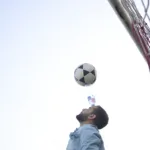Football is the world’s most beloved sport — but it’s also one of the most physically demanding. From youth academies to elite levels, injuries in football are an unavoidable part of the game. Understanding them is crucial for every player, parent, coach, and football agent. This article explores the most common types of injuries, their causes, prevention strategies, and what players can learn from the careers of top professionals.
Injuries in Football: Statistics
Injury types in football are classified by frequency:
- 35% — Knee injuries
- 20% — Ankle injuries
- 15% — Hamstring and quadriceps strains
- 10% — Groin muscle and tendon injuries
- 10% — Upper limb injuries (wrists, elbows, fingers)
Additional injuries include back pain, bone fractures, and concussions, though they are less common. Let’s take a closer look at the most frequent ones and how to deal with them.
Common Injuries in Football: From Sprains to ACL Tears
You’re more likely to become injured during a competitive match than during training sessions. You might get a football injury from:
- tackling
- running
- twisting or turning
- jumping or landing
- using the same muscles repeatedly (overuse/fatigue)
- hurting an area you’ve injured before if it’s weak (re-injury)
- foul play or colliding with an opponent
- lack of physical conditioning (doing ‘too much too soon’)
The most common include:
1. Ankle Sprains
When you play football, you’re often running on an uneven surface and sometimes have to change direction at a moment’s notice. This could cause your ankle to roll inwards or outwards, and the ligaments that stabilise your ankle joint could become overstretched.

- What it is: A stretching or tearing of ligaments around the ankle joint.
- Typical cause: Missteps, tackles, or poor landing.
- Recovery time: 1–6 weeks, depending on severity.
- Real case: Neymar missed key Champions League matches due to recurring ankle injuries.
Insight: Weak ankles are often the result of insufficient neuromuscular training. Strengthening stabilizer muscles and proprioception exercises significantly reduce re-injury rates.
2. Hamstring Strains
Hamstrings are a group of three powerful muscles located at the back of your thigh. These muscles play a crucial role in explosive football movements, especially during sprinting and sudden acceleration. In football, players often switch rapidly from a standstill to full speed within seconds — putting intense pressure on the hamstrings.
If these muscles lack flexibility (due to insufficient stretching) or strength (from poor conditioning), they become more vulnerable to overload. This often results in a hamstring strain — one of the most common injuries in football. Proper warm-ups, strength training, and regular mobility work are essential to prevent this type of injury and keep players on the pitch.
In Brief:
- What it is: Damage to the muscles in the back of the thigh.
- Causes: Overstretching during sprints or fatigue at the end of matches.
- Recovery time: 2–8 weeks, but reinjury is common if rushed.
- Example: Gareth Bale’s career has been heavily impacted by hamstring issues.
Tip: Eccentric strength training, like Nordic curls, is proven to cut hamstring injuries by up to 51%.
3. Anterior Cruciate Ligament (ACL) Tears
Your ACL is a very important stabilising ligament in your knee. It’s commonly injured if your lower leg stays planted while the upper part of your leg twists or moves. For example, during a tackle or when landing a jump while in motion.
- What it is: A tear of the main stabilizing ligament in the knee.
- Causes: Sudden stops, changes in direction, or awkward landings.
- Recovery: 6–12 months and often requires surgery.
- Real case: Alexia Putellas (Spain) and Virgil van Dijk both missed nearly a full season due to ACL injuries.
Agent alert: ACL tears drastically affect transfer value and contract negotiations. Early detection of biomechanical risk factors (valgus collapse, poor movement patterns) is key.
4. Groin Injuries
- Common in players with poor hip mobility or imbalance between inner/outer thigh muscles.
- Recovery ranges from 2 weeks to several months.
Prevention: Incorporate Copenhagen planks and monitor match/training load ratios.
The Real Cost of Football Injuries
Injuries can derail not just seasons but entire careers. They impact:
- Player development (lost match rhythm)
- Scouting opportunities
- Mental health
- Market value (as tracked by platforms like Transfermarkt)
Stat: A 2023 UEFA report found that 65% of long-term injured players aged 18–21 never returned to elite levels.
Psychological Impact of Injuries in Football: Beyond Physical Pain
Injuries in football can have a significant psychological impact on players, affecting their mental health and well-being, as well as their performance and recovery. Common psychological responses include sadness, anxiety, fear of reinjury, depression, and a loss of identity, particularly for those whose sense of self is closely tied to being an athlete.
An often overlooked aspect is the mental toll:
- Isolation from team dynamics
- Fear of re-injury
- Loss of confidence
- Contract or selection anxiety
Recovery programs should include sports psychologists or mindset coaches. Players like Marco Reus have spoken about the mental challenges of repeated setbacks.
Prevention Strategies: What the Pros Do Differently
✅ Load Management
- Use wearables to track fatigue and adjust training volume.
- Example: Many top academies limit high-intensity sessions before matches to reduce injury risk.
✅ Warm-Up Protocols
- Proven to reduce injuries by up to 30%.
- Yet, many youth teams still skip structured warm-ups.
✅ Nutrition & Recovery
- Anti-inflammatory foods (like berries, oily fish, turmeric) speed up healing.
- Sleep is critical: <7h increases injury risk by 1.7x.
Injuries in Football: Innovations in Recovery
- Cryotherapy, hyperbaric chambers, and blood flow restriction therapy are now common at elite levels.
- Tools like GPS tracking and AI video analysis help detect poor movement patterns before injuries occur.
Example: FC Barcelona uses AI to predict which youth players are at high injury risk based on training footage and biometrics.
Advice for Players, Parents, and Agents
- Document all injuries: Have detailed records for club negotiations and medical transparency.
- Don’t rush returns: Reinforcing bad movement can cause chronic problems.
- Invest in screening: Functional Movement Screen (FMS) and jump/landing analysis are cheap but powerful tools.
Takeaway: Make Injury Management Part of the Plan
Whether you’re a teenage footballer dreaming of La Liga, a parent investing in your child’s development, or an agent guiding careers — injury awareness is part of long-term success.
➡️ On pro-sportagent.com, we’ll continue offering tools, expert chats, and smart content to help young footballers not just play — but thrive.










